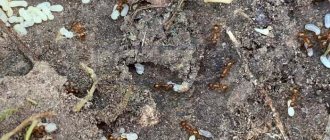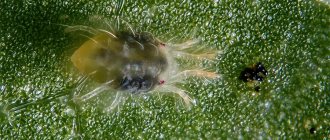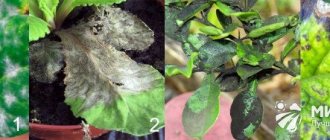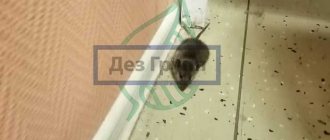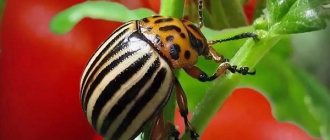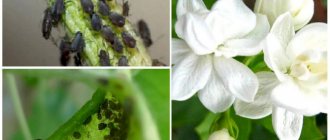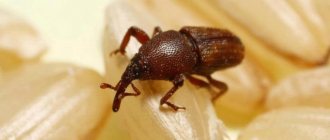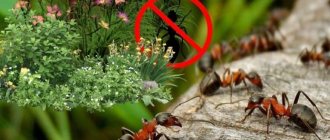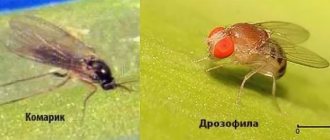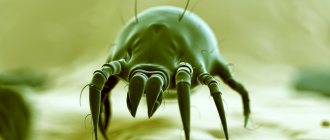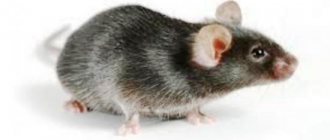To enjoy your favorite conifers, you need to take care of their health. After all, even such unassuming crops are often affected by diseases and pests. Read our article about what you should be wary of and how to resist adversity.
Coniferous plants are considered more hardy than representatives of deciduous species. They are used for decorative purposes, to create hedges and protective plantings. But not everyone knows that coniferous trees are sometimes subject to dangerous diseases and pest attacks. This happens especially often in the spring, when trees are weakened by winter cold and lack of light and nutrients. What misfortunes await the owners of coniferous trees?
Brown Schutte
The most common and dangerous disease of conifers is one of the varieties of schutte - brown schutte, or brown snow mold. It is caused by a fungus of the genus Herpotrichia, which settles on pine, juniper, fir, spruce, cedar, cypress and thuja. It primarily affects young plantings and plants in nurseries. For its development, a temperature of about 0.5°C is sufficient, and lesions are detected only after the snow has melted. On dead brown needles, a black-gray coating of mycelium forms and black dotted formations of the causative fungus are visible. Thin branches gradually die off. The development of the disease is facilitated by high humidity, dense plantings and damage to plants, as well as abundant snow cover and its prolonged melting.
Prevention and control measures for brown schutte
|
Bedbugs
Order: Hemipterans, or arthropodous. Kinds:
- spruce subbark;
- pine root.
Description:
- distinctive feature - odorous glands that secrete an unpleasant odor;
- body length - from 3 to 10 mm;
- color - most often brown, green or red, there may be spots and patterns.
Signs of plant infection:
- sticks to the trunk, breaks the integrity of the bark, sucks out juices;
- the bark begins to peel off in whole pieces;
- under it, spots are found on the trunk - gray-white, brown-red, yellowish;
- the needles turn pale, become thinner, and look painful;
- the top dries out.
How to fight:
- spraying with antiseptics: Lepidocide, Lepidobactocide, Bitoxibacillin;
- spraying with chemical insecticides: Actellik, Confidor;
- treatment of pine with Arborjet, which is injected directly into the trunk;
- spring treatment of conifers with preventive agents: Decis, Karate, Aktara, Enzhio.
Among the folk remedies for controlling such pests, the most effective is treatment with a solution of potassium soap and water, citrus fruit or tobacco infusion. Bed bugs attack mainly pine, but they also do not disdain cedar and larch. Those most at risk are trees with dried out bark, peeling plates, and a green layer of moss on the trunk.
Rust diseases
Rust affects most conifers, and its subspecies differ slightly from each other. Yellow-orange spots appear on trees and shrubs affected by the fungus, then spore-bearing bags are formed from the mycelium, and brown growths appear on the needles. Typically, rust appears on conifers after it has formed on grass crops. The needles gradually turn yellow, dry out and fall off, the plant looks thinned out and even slows down in growth over time.
Rust prevention and control measures
|
Aphids
Order: Hemipterans, or arthropodous.
Kinds:
- spruce root;
- green spruce or Sitka;
- gall yellow and red;
- juniper;
- pine;
- thuja.
Description:
- small insects whose body size does not exceed 2-3 mm;
- special proboscis that pierce shoots and leaves;
- can be either winged or wingless;
- The color is most often light pale greenish or brown.
Signs of plant infection:
- white fluff;
- sticky hands after rubbing it;
- growth slowdown;
- shortening shoots;
- shedding of needles;
- drying out of conifers.
How to fight:
- spraying plants with insecticides: Aktara, Formate, Karbofos, Neoron, Iskra;
- if after two treatments with the same drug (with an interval of 10 days) the pest remains, it is recommended to change the product to another;
- if the lesion is small, folk remedies can also cope with it: a solution of potassium soap and an infusion of wood ash.
The outcome depends on the scale of the lesion. If there are few pests, chemical insecticides will destroy them in 20 days. If the invasion resembles an epidemic, prepare for the fact that you will have to part with the plant.
Gray mold (rot)
This disease is caused by the fungus Botrytis cinerea and is manifested by the formation of ash-gray cobwebby mycelium on the needles. The mycelium can exist for up to 2 years and at the same time infect new parts of plants. The development of the disease occurs in the fall, and by spring the mycelium grows into the root system of young seedlings, causing tissue death and death. The disease develops especially actively in conditions of increasing humidity and thickened crops, in places where moisture accumulates and in shaded areas.
Measures to prevent and combat gray mold
|
Moths
Another name: land surveyors. Order: Lepidoptera (butterflies).
Kinds:
- fir;
- pine;
- mulberry;
- winter
Description:
- Butterflies have an average wingspan of about 30 mm;
- thin, weak body, but wide, tender wings;
- spiral proboscis;
- color - grayish;
- The caterpillars are thin, long, naked, colored to match the color of bark or leaves, and disguised as twigs, so it is extremely difficult to notice them on a tree.
Signs of plant infection:
- the first lesions (eaten needles) appear on the lower branches;
- eaten plants curl and dry out;
- moths do not disdain other vegetation, so their caterpillars can be found not only on fir or pine, but also on nearby plants;
- If after a fir moth the tree most often survives, then after a pine moth it is in danger of drying out.
How to fight:
- spraying with insecticidal preparations;
- treatment with repellents during butterfly flight (late May - early June);
- in the fall, it is obligatory to dig up the soil under the tree to destroy the pupae hiding there.
Moths do not like moisture, so they never attack conifers on which mosses or lichens grow.
Fusarium
Seedlings and young coniferous plants are subject to Fusarium drying out, which is provoked by fungi of the genus Fusarium. Sometimes you can find such a name as tracheomycosis wilt . The main danger of fusarium is that it first affects the root system, which turns brown and rots, and then passes into the vascular system, filling it with fungus and preventing the access of nutrients. The needles turn yellow, red, become coarse and fall off, the tree weakens and gradually dries out. The main sources of infection are contaminated soil and planting material, as well as plant debris.
Measures for the prevention and control of fusarium
|
Non-infectious diseases of coniferous plants and elimination measures
Burn. Solar radiation is especially dangerous for young trees. Snow cover reflects rays and increases moisture evaporation. Roots in frozen soil are unable to compensate for losses. Sap flow begins when the soil warms up to +4°C; up to this temperature the roots are dormant. Young conifers planted in the fall can die from burns. My young pine tree died; we didn’t cover it for the winter. I noticed that glare from greenhouses, house windows, and shiny roofs act like mirrors. If brown or yellowish spots appear on the crown, you need to look for where the bright light is coming from.
Measures to protect against the spring sun:
- Young trees are helped by spraying - the branches are generously moistened with a sprayer or garden sprayer.
- You can throw burlap or covering material over small trees in spring or autumn. It will protect from the scorching sun and drying wind.
- By scattering black soil or ash on the snow, they “start” the process of snow melting, and the roots begin to absorb moisture.
When planting trees, it is important to maintain the integrity of the root ball of earth. When seedlings are purchased in pots, they take root better. Pines are more resistant to transplantation; their needles grow back after rooting. The most capricious is the forest spruce. She usually gets sick for a long time; it is advisable to shade her in the spring for the first three years. Of the junipers, I recommend the varieties “Skyrocket” and “Bluealps” (Cossack).
Other reasons for yellowing needles:
- Mechanical injuries to trees occur due to snow load and damage by animals.
- An undeveloped root system is typical for weakened seedlings; it is better to immediately choose decent planting material.
- In case of strong return frosts with active snow melting, the bark cracks; it must be checked and the cracks must be covered with varnish.
- In flooded areas, stagnant water provokes the development of root rot and changes the acidity of the soil.
The resistance of conifers to non-infectious lesions is increased by bioactive drugs:
- Kornevin (stimulates the growth of the root system)
- Super humisol – a balanced mixture of trace elements and minerals;
- Zircon is a complex action drug;
- Siliplant is a silicon-containing chelate microfertilizer.
Timely feeding strengthens the immunity of plants, they are less susceptible to burns, and grow faster in the spring.
Bark beetles (Scolytinae)
A real scourge of forests. If your area with conifers is located near a forest, be careful, sooner or later the conifers will become the object of attention of this beetle. Most of them live directly under the bark of conifers, sometimes going deep into the trunk and gnawing numerous passages in the wood. The length of the beetle does not exceed 1.2 cm, and its dark color makes it inconspicuous. The female lays eggs directly into the passages she has gnawed, and the hatched larvae lay out their own “routes.” After overwintering, they move outside and begin to fly. First of all, bark beetles select sick, weak and dry trees, finally destroying them.
Measures for prevention and control of bark beetle
|
Sawflies (Symphyta)
This category includes a huge number of insects that are pests of spruce and pine (they even make nests on some trees). European, Canadian and Serbian spruces recover quite quickly from sawfly attacks, but pines succeed to a lesser extent. Most often, coniferous plants are damaged by common and red sawflies . They look like small bees with a voluminous abdomen. Females lay eggs in cuts in plant tissue and after some time larvae emerge, looking more like bright green caterpillars. From May to the end of June, they intensively eat young shoots, which is why the branches seem burnt, dry out and die.
Measures for prevention and control of sawflies
|
Hermes (Adelgidae)
This is a special group of parasitic insects that most often live and feed on spruce and pine. At the end of June early hermes , closer to August it is replaced by yellow hermes , and then, at the beginning of autumn, late hermes . Outwardly, these small insects resemble aphids, but you have to try hard to see them. They feed on tree sap, but in addition to sweet secretions, they also form dense and hard growths (galls), similar to a small cone, which protect them from external factors. In autumn, larvae are located at the base of the buds, which in the spring turn into adult insects. They damage buds and deform branches, eventually causing tissue death and plant death.
Prevention and control measures for hermes
|
Moli
Order: Lepidoptera (butterflies). Kinds:
- juniper shoot;
- larch cap and miner.
Description:
- almost always lead a twilight lifestyle;
- distinguished by a shaggy large head;
- color - whitish-gray.
Signs of plant infection:
- usually begins in May;
- eaten needles, which moth caterpillars never completely eat, but after them they fall off;
- yellowing of needles;
- white coating on the crown and branches;
- the formation of cobweb nests in which caterpillars live.
How to fight:
- collecting and burning spider web nests;
- treatment with insecticides (Iskra, Komandor, Fufanon).
First of all, the caterpillars of this pest attack young, immature seedlings.
Scale insects (Diaspididae)
Scale insects and false scale insects are frequent “guests” on thujas, junipers and yews. They are covered with a protective “shell” and look like small growths or plaques on the foliage. In females the scutes are round, up to 2 mm in diameter, while in males they are oblong. The color of the “shell” can vary from red-brown to dark brown. The greatest damage is caused by the larvae, which immediately after hatching begin to suck all the juices from the plant. Pseudoscale insects are also quite dangerous pests; their shell does not fuse with the insect’s body, and even if the shield is picked off, the parasite will remain on the plant. It is possible to determine that a tree or shrub is being attacked by scale insects by these small “growths” under which the adult insect is hiding. The needles lose their shine, turn brown, and wasps flock to the scale insects' secretions. The needles become covered with plaque, turn yellow and fall off, and the tree gradually dies.
Measures for the prevention and control of scale insects
|
We examined only the most common diseases and pests of coniferous plants, which cause maximum damage to them. In fact, there are much more of them, so you should regularly carefully inspect the plantings and take timely care of the health of your favorite plantings.
Ticks
Spider mites are one of the most ubiquitous pests. It affects almost all types of plants, except aquatic ones. You can notice ticks on larch, spruce and juniper along the web. Ticks are active in spring and summer, during which they may appear several times.
The size of individuals directly depends on their fatness, the length of females is 0.4-0.6 mm, males - 0.3-0.45 mm. Soft-bodied animals are characterized by an ellipsoidal shape, the upper part of the body is convex, the lower part is flat. Tick larvae are transparent, light green to green-brown in color, with 2 distinct, large dark spots on the sides. The color of females wintering from late summer to spring is orange to bright red. All adult ticks have 8 legs.
Spider mites feed on the contents of plant cells. The presence of the pest is indicated by a thin cobweb and the presence of small white dots on the needles. In case of severe damage, it turns completely white, the entire plant is covered with cobwebs, and a moving mass consisting of the bodies of parasites is visible on the needles.
The main prerequisite for the appearance of mites is low air humidity, so regular spraying of the outer parts of plants is a good prevention of the occurrence of the pest.
Control measures
The most effective way to get rid of ticks is to fight them with modern chemicals. Please note that spider mites are arachnids, not insects. It is useless to use insecticides against it.
It needs to be combated with other drugs - acaricides (Apollo, Flumite, Borneo, Floromite, Envidor) and insectoacaricides (Agravertin, Fitoverm, Akarin, Oberon, Actellik) . To destroy the most resistant individuals, it is necessary to treat with the selected drug several times.
